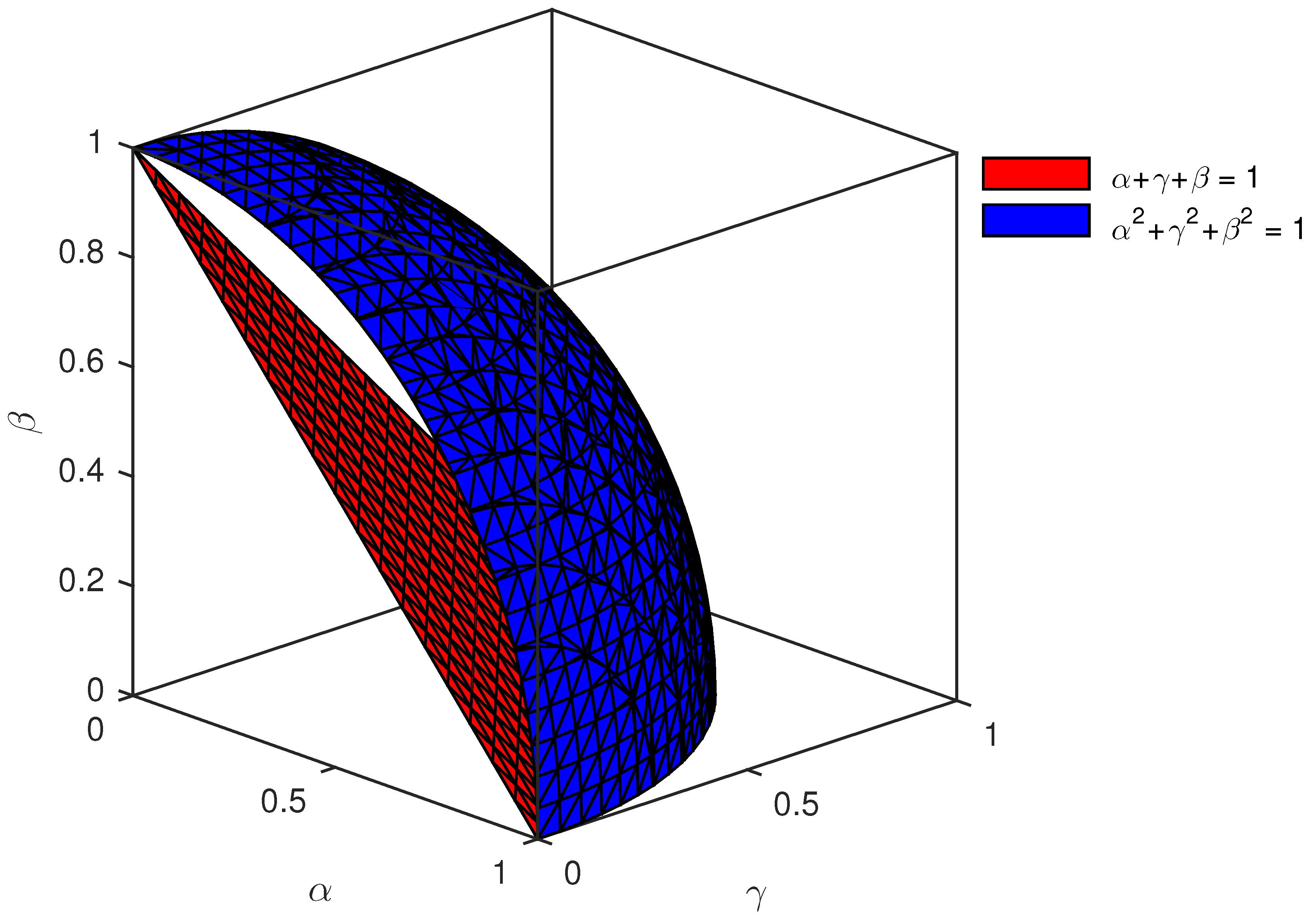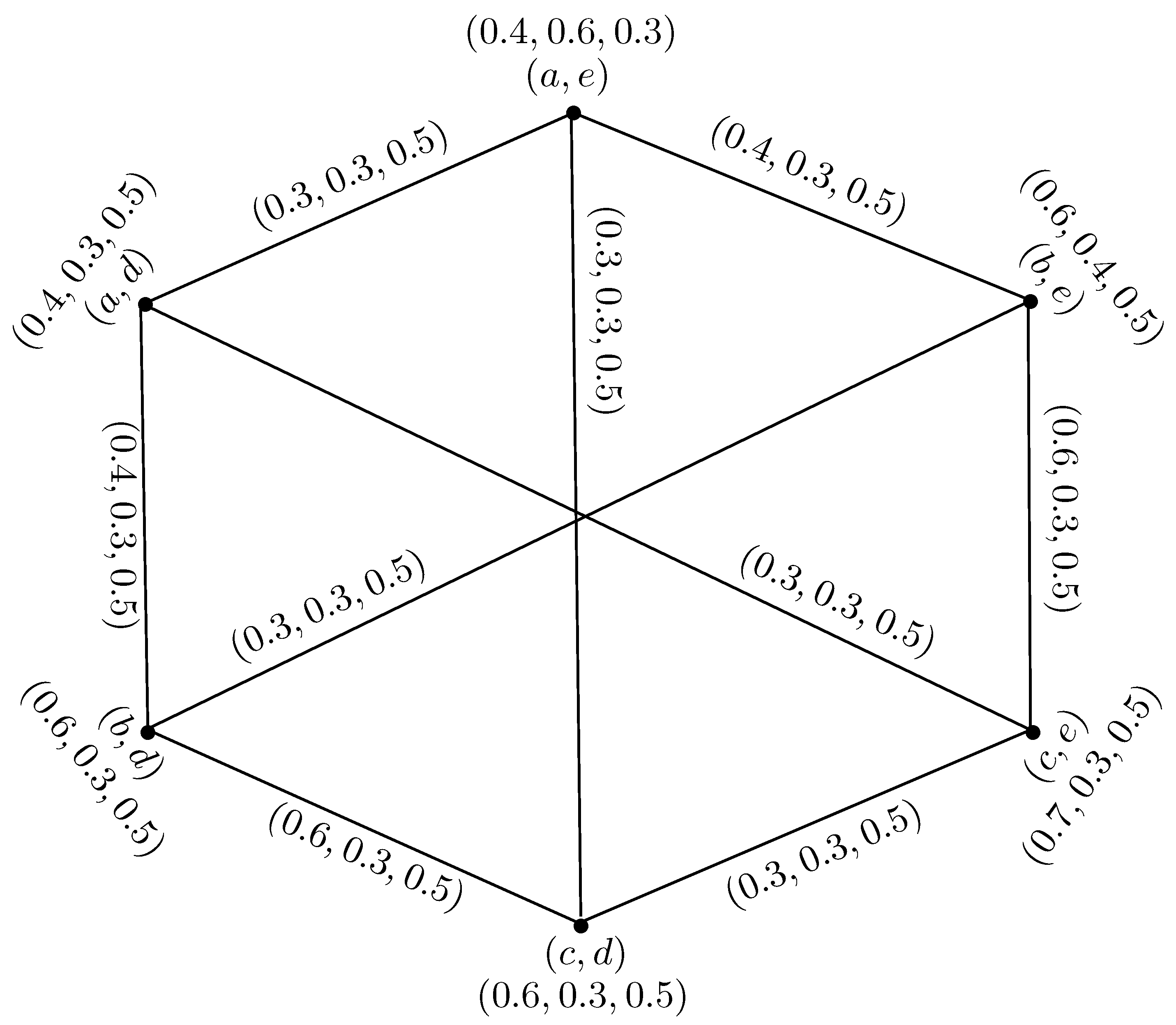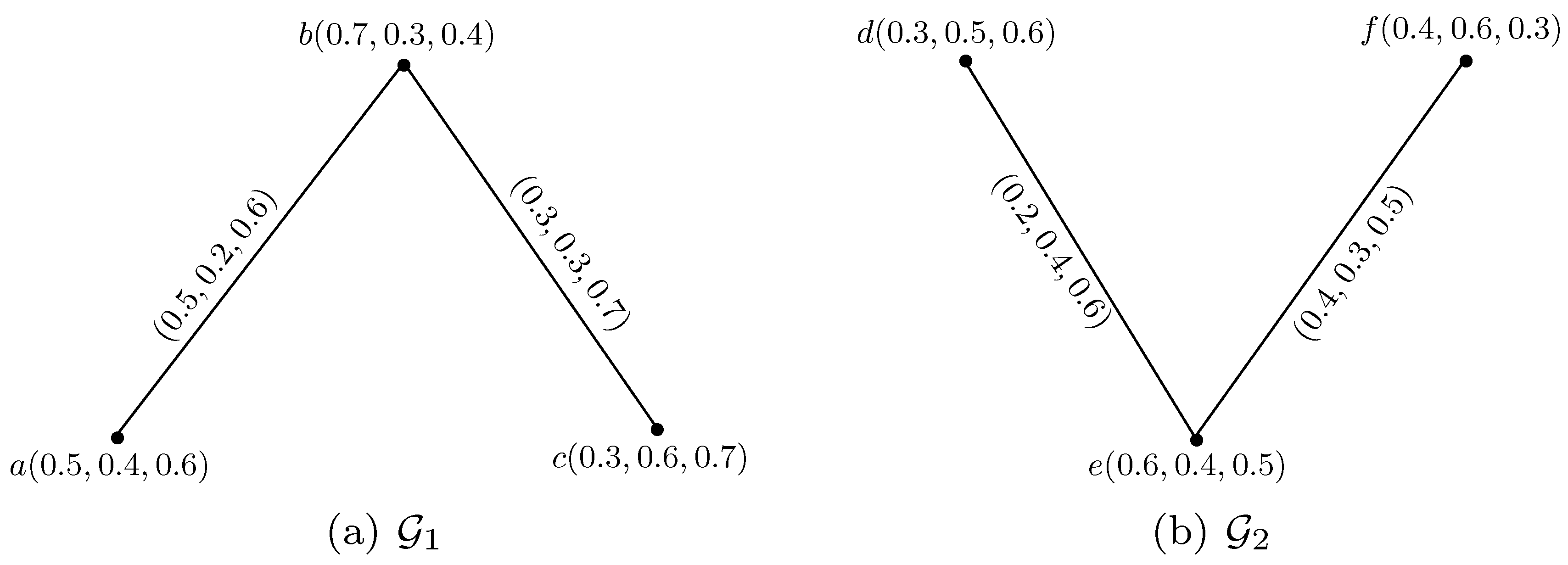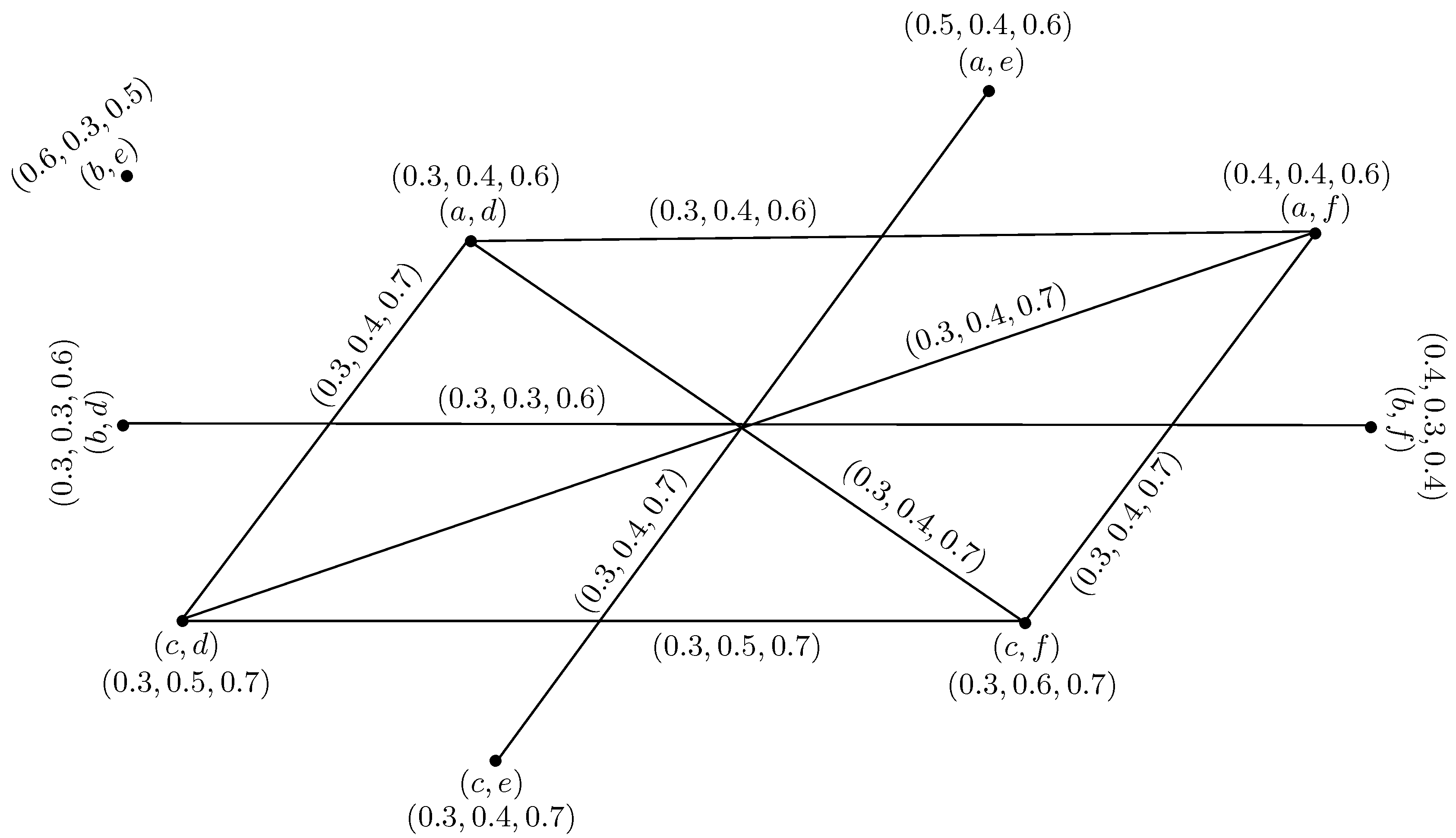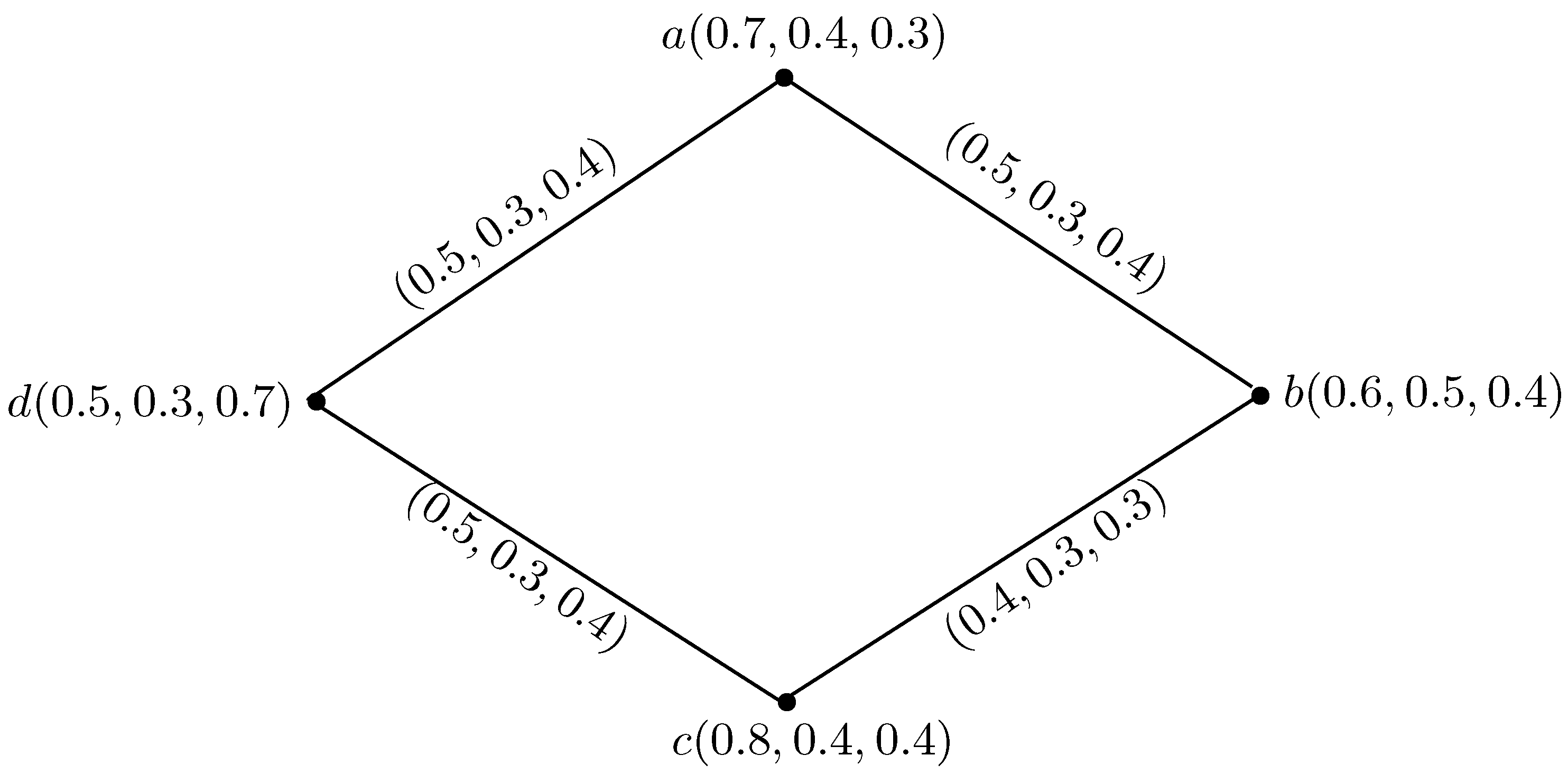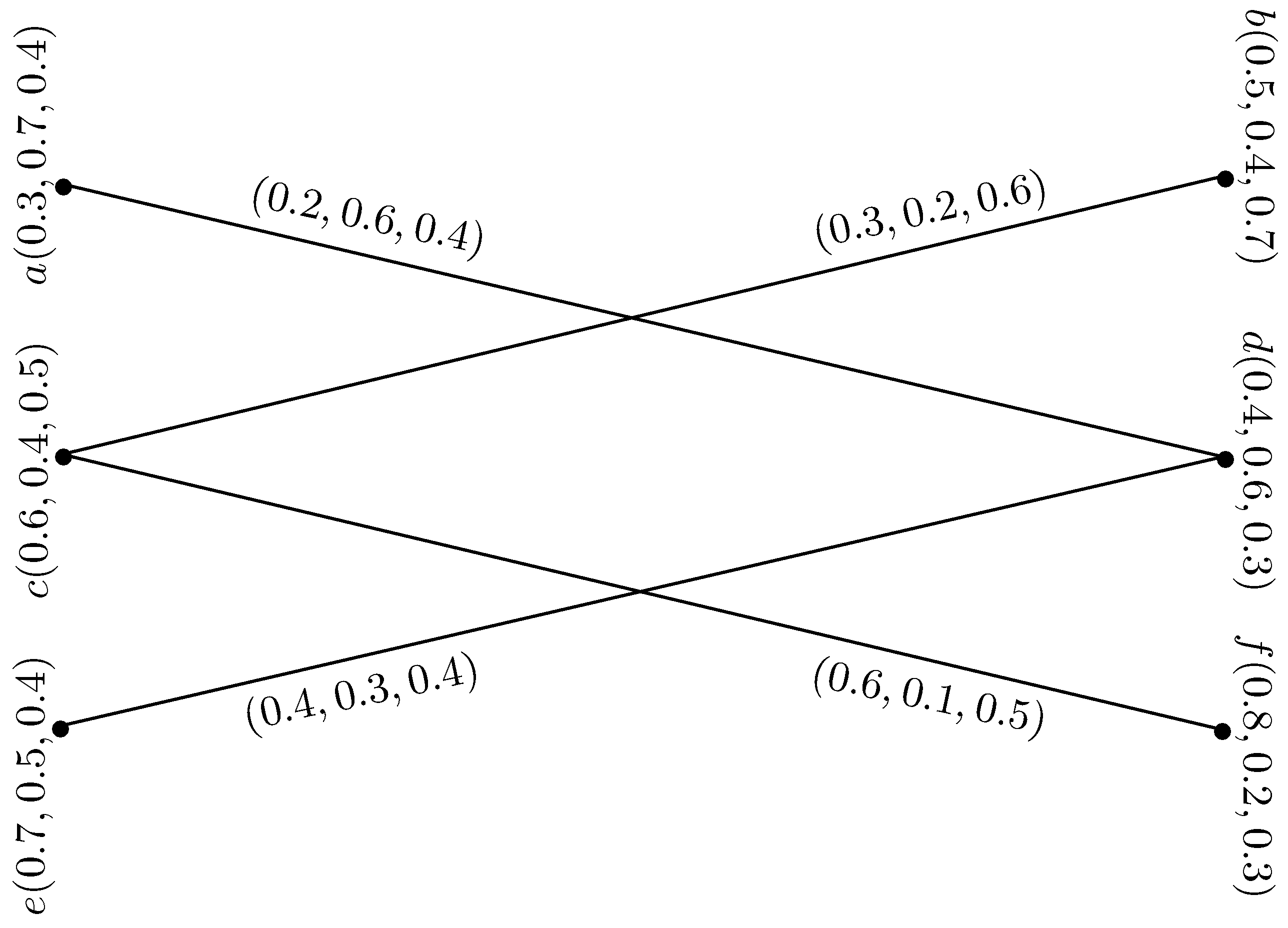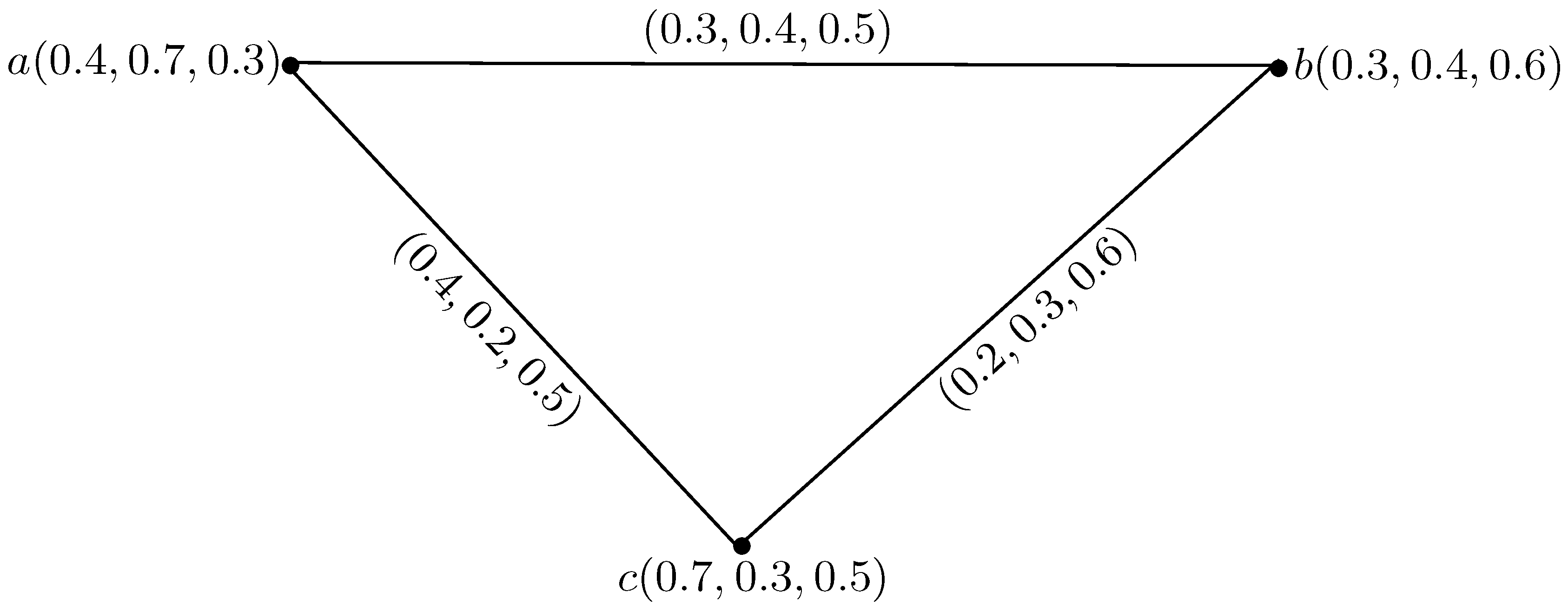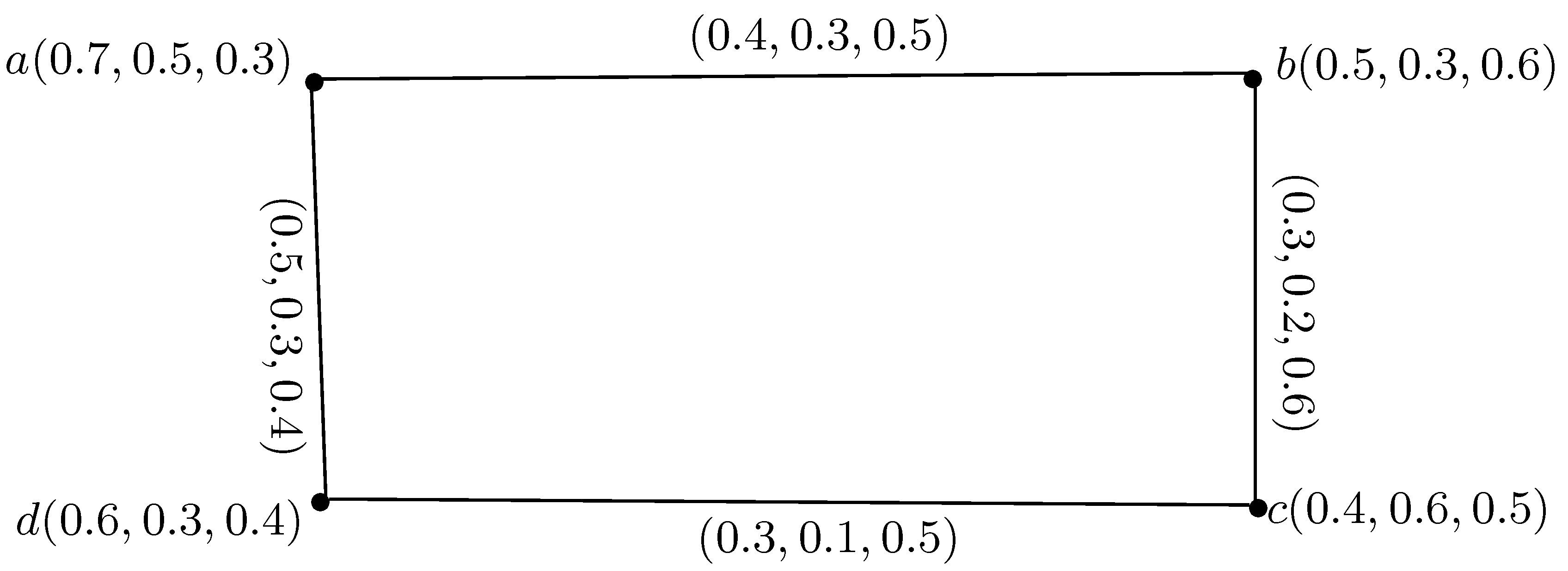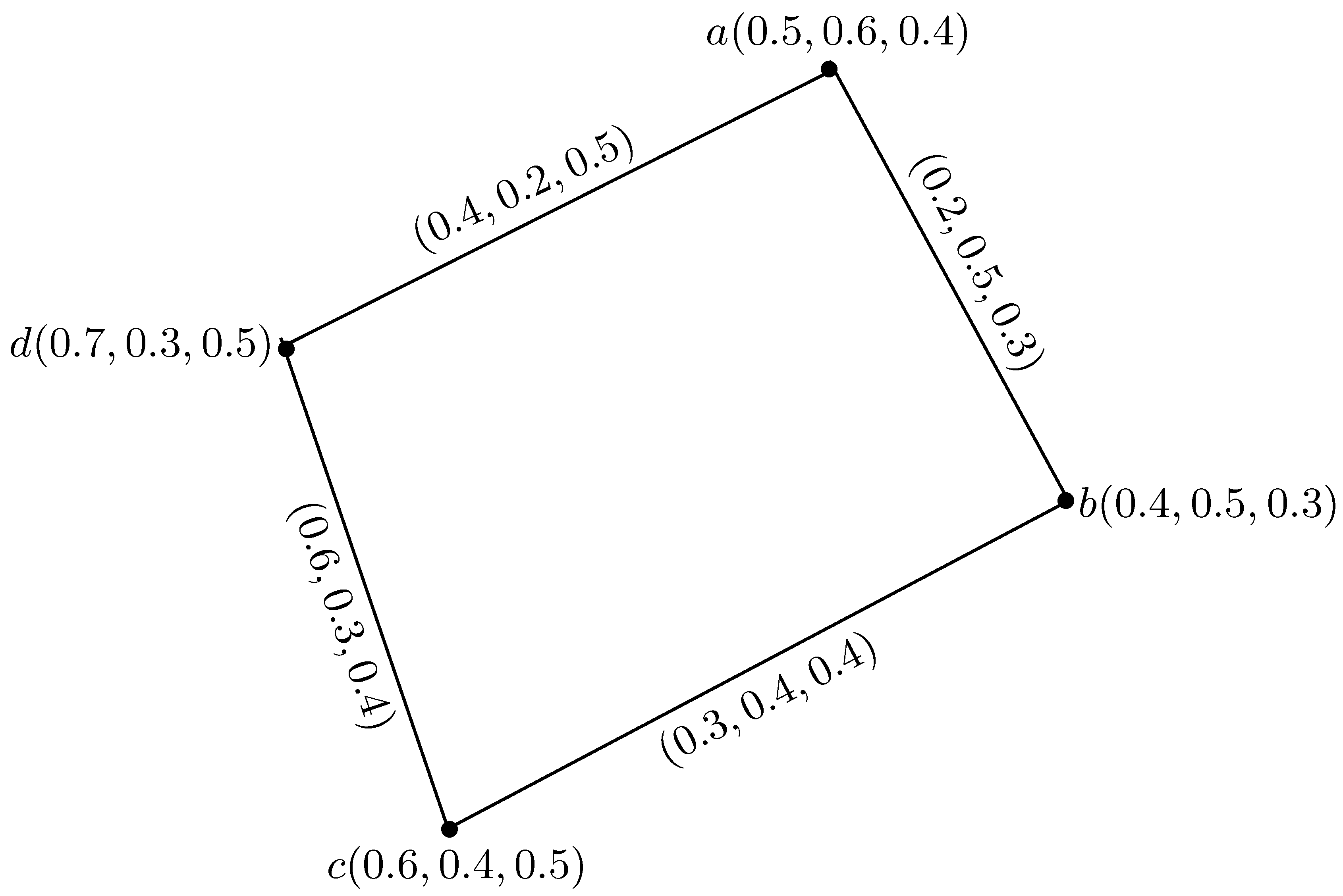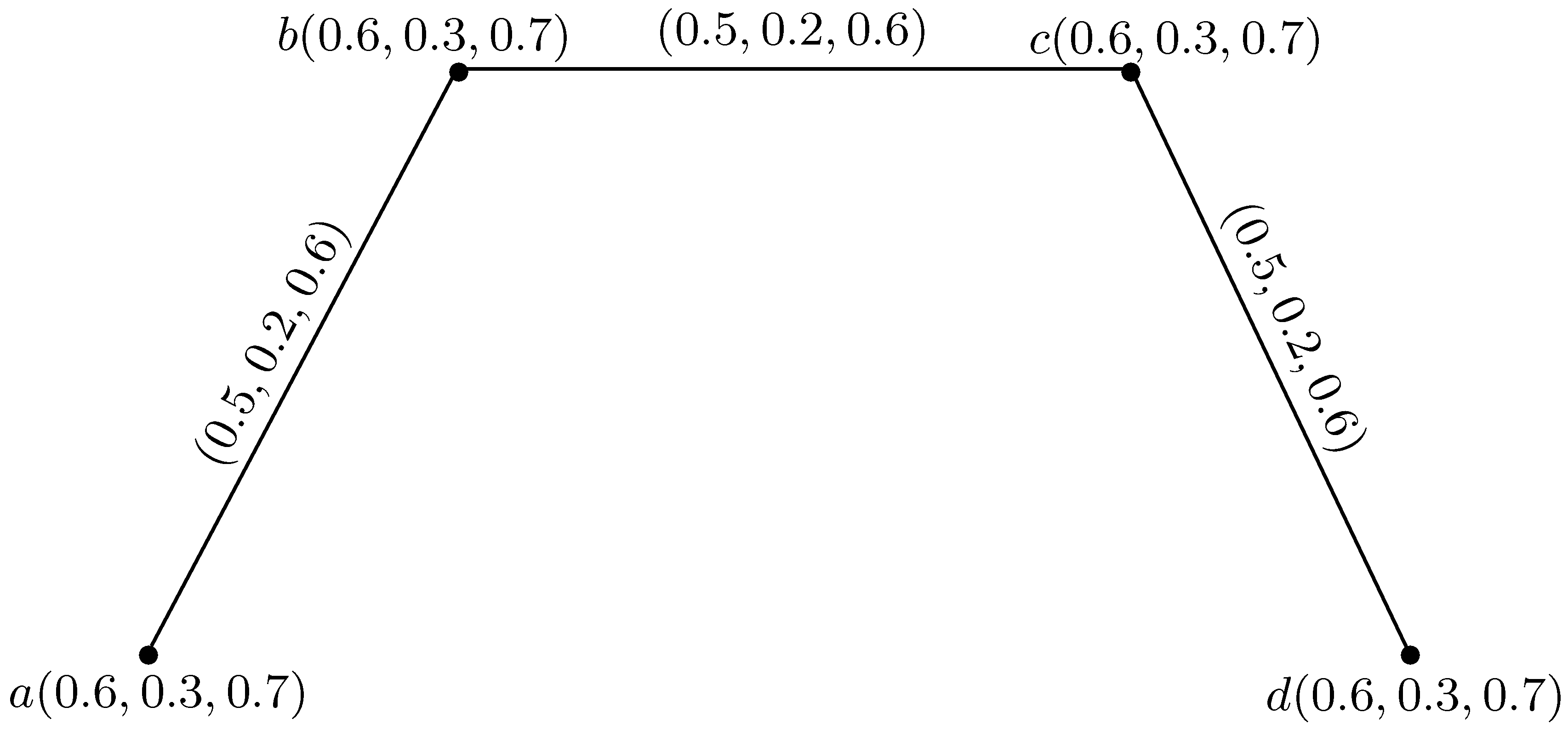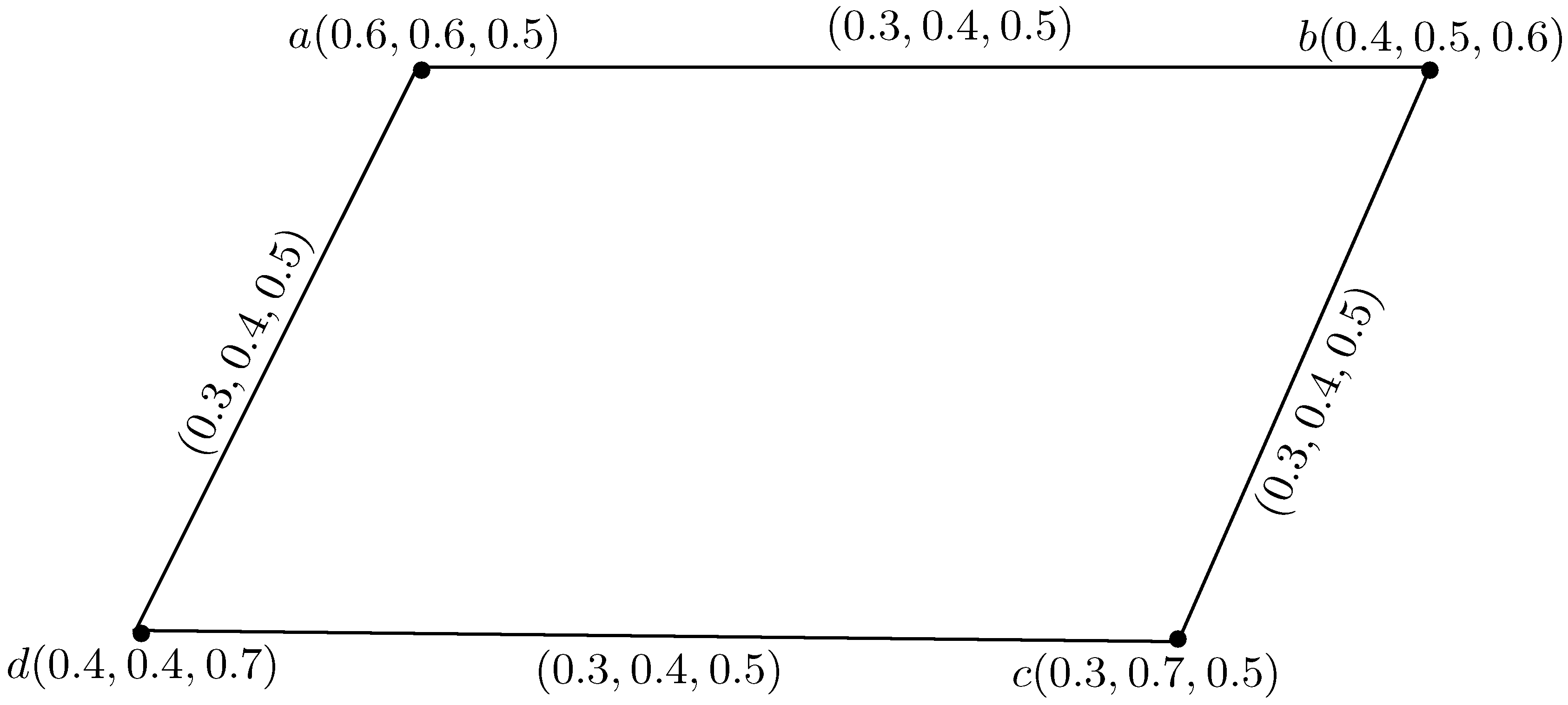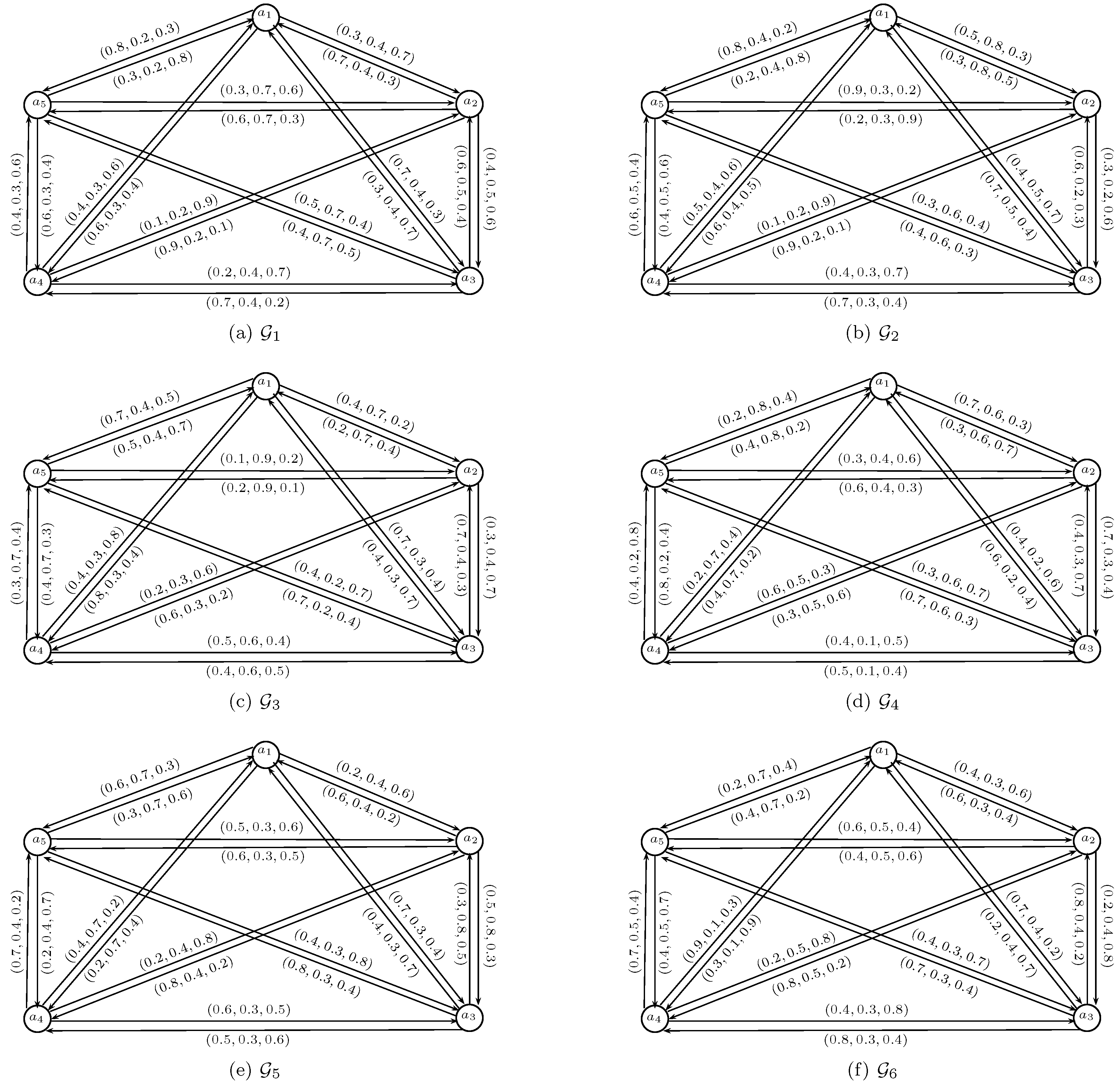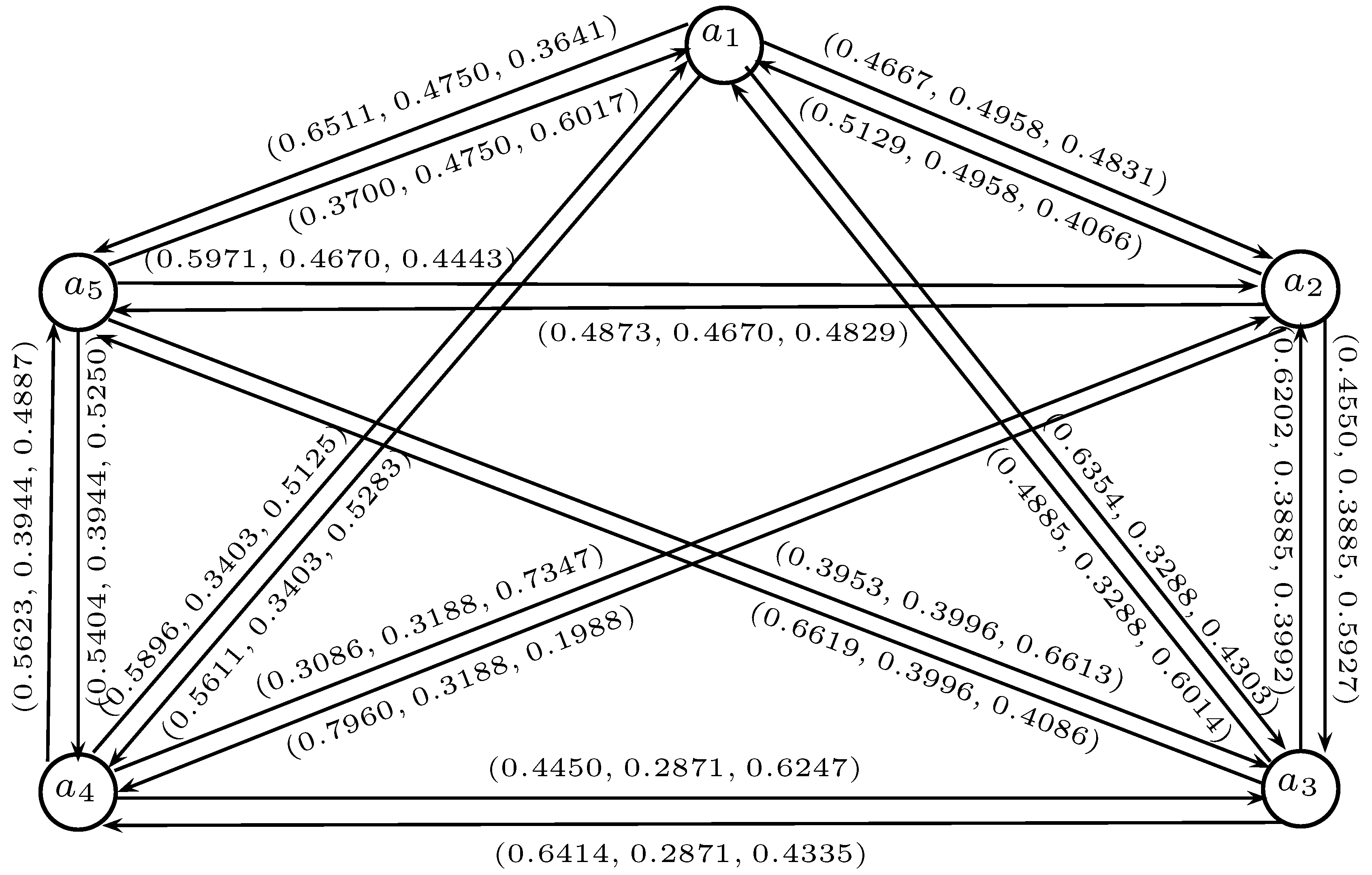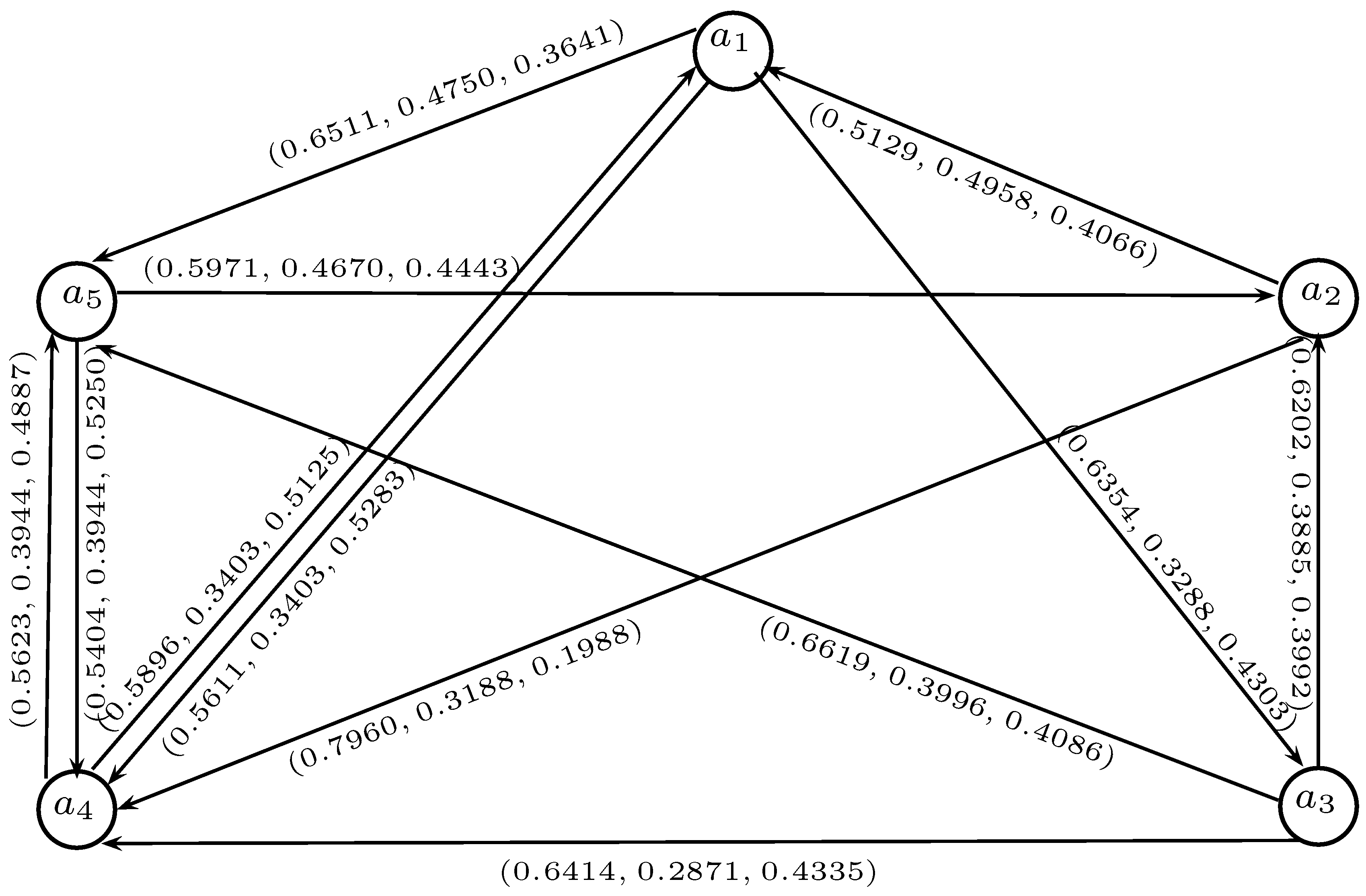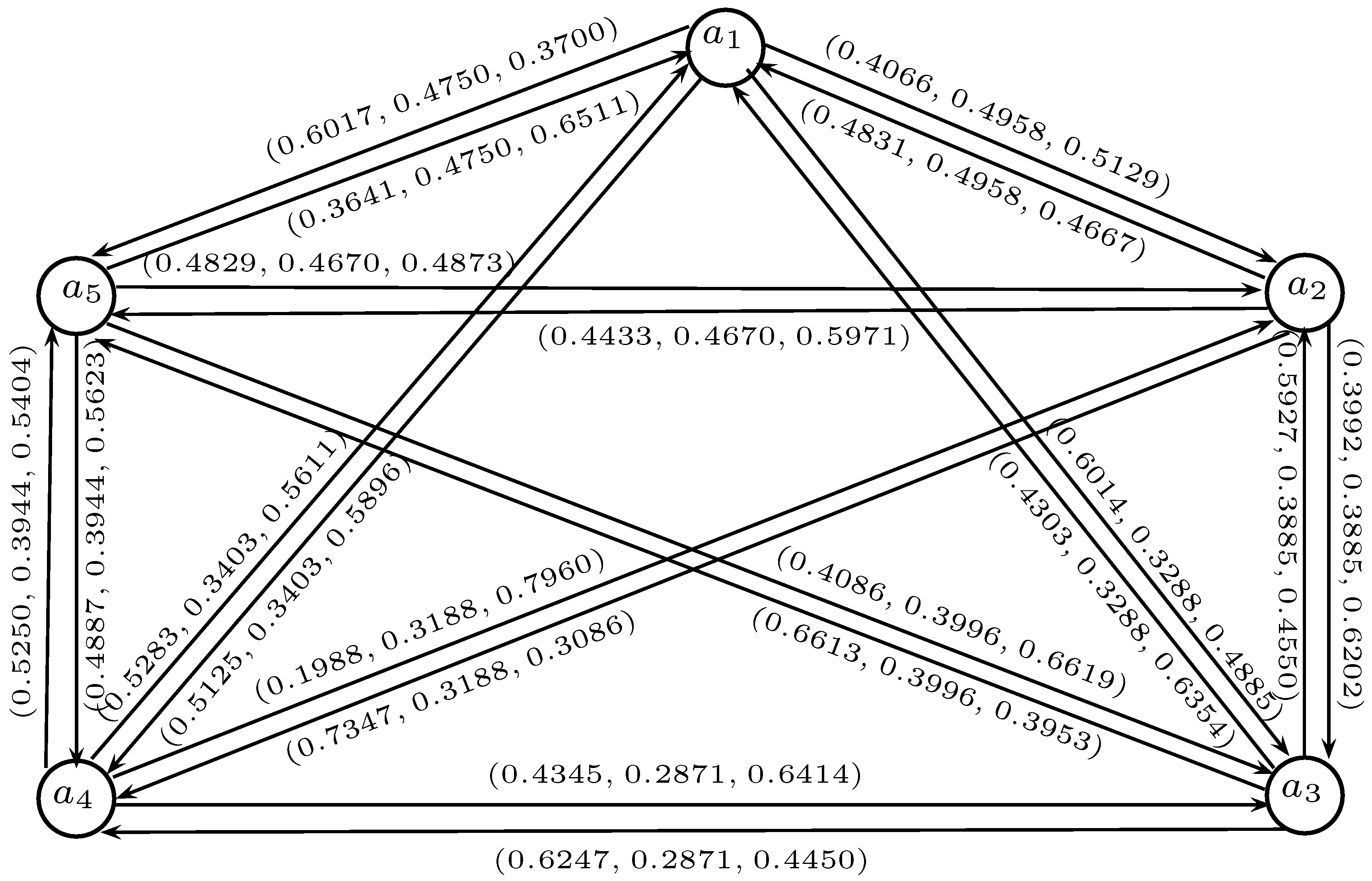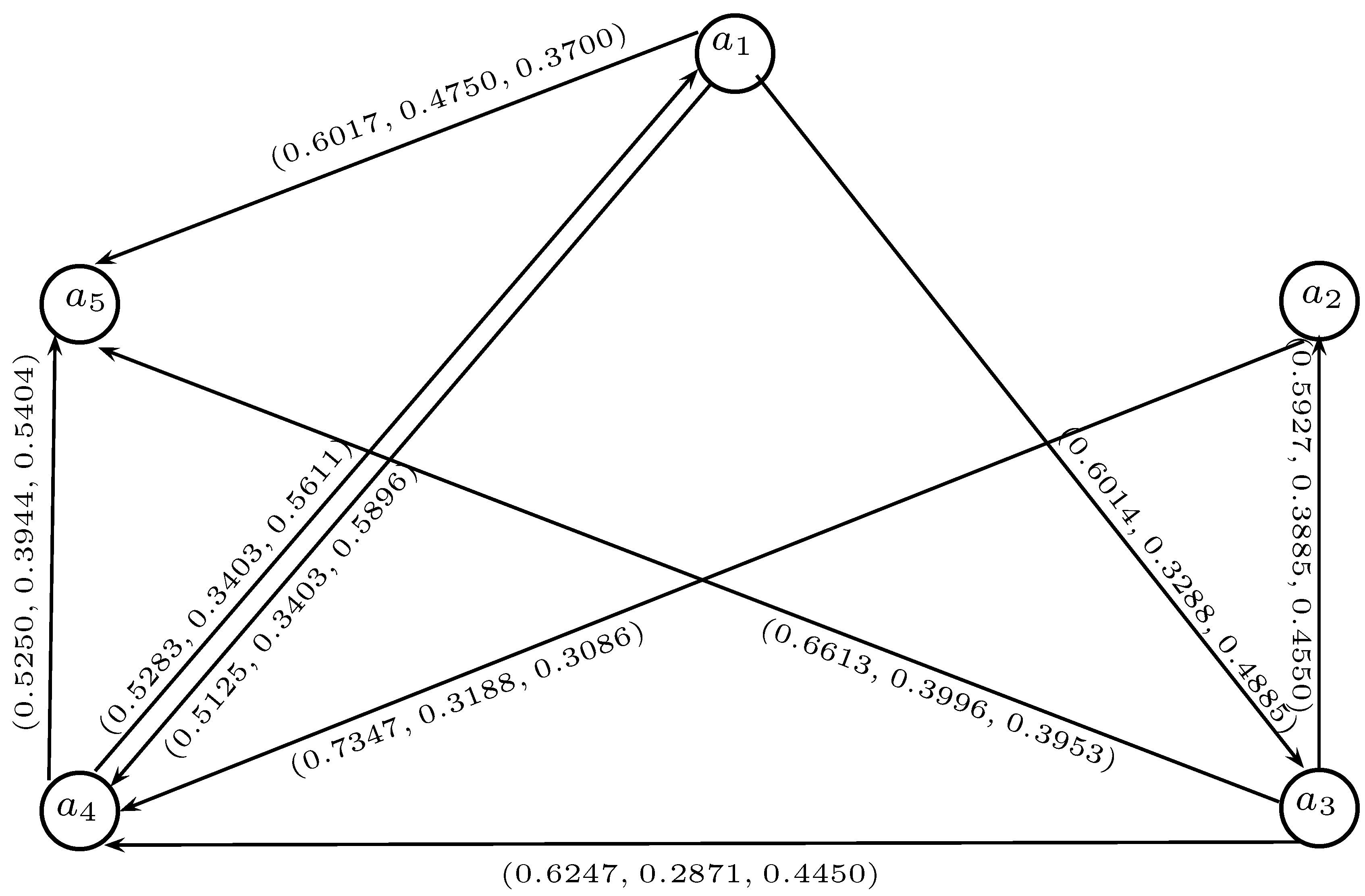1. Introduction
Fuzzy set theory proposed by Zadeh [
1] is an extension of classical set theory. Zadeh’s remarkable idea has found many applications in several fields, including chemical industry, telecommunication, decision theory, networking, computer science, and management science. Atanassov [
2] introduced the intuitionistic fuzzy set (IFS) as an extension of fuzzy set (FS) theory. He broadened the idea of FSs by defining the truthness degree
alongside the falseness degree
with the requirement
Fortifying the idea of IFS, Yager [
3] proposed Pythagorean fuzzy sets (PyFS), which broadened the space of participation by presenting a new limitation,
Cuong [
4,
5] initiated the concept of the picture fuzzy set (PFS) as a direct extension of intuitonistic fuzzy sets, which may be adequate in cases when human opinions are of types: yes, abstain, no, and refusal. A picture fuzzy set gives three degrees to the elements named truthness degree
abstinence degree
, and falseness degree
under the condition
where
is the refusal degree. PFSs have many applications in fuzzy inference, clustering, decision making etc.
Zeng et al. [
6] explored the picture fuzzy divergence measure in multi-criteria group decision making. Garg [
7] presented some picture fuzzy aggregation operators. Recently, Liu et al. [
8] defined picture fuzzy weighted distance measures and their application to investment selection. Zhang et al. [
9] explored picture fuzzy Dombi Heronian mean operators. For further study on picture fuzzy sets, one may refer to [
10,
11,
12,
13,
14,
15].
The spherical fuzzy set (SFS), proposed by Gündogdu and Kahraman [
16], is an extension of PFS, as it provides enlargement of the space of degrees of truthness
abstinence
, and falseness
in the interval
with a condition
Ashraf et al. [
17] presented the notion of SFSs with applications in decision making problems. Another extension suggested by Li et al. [
18] in 2018 is the
q-rung picture fuzzy set (q-RPFS). The proposed concept relaxes the constraints of picture and spherical fuzzy sets with
This model can express vague information more flexibly and accurately with increasing
q rungs.
Graph theory has become a powerful conceptual framework for modeling and for solutions of combinatorial problems that arise in various areas, including mathematics, computer science, and engineering. Many real life problems can be represented by graphs. Graph theory was first presented by Euler, when he handled Königsberg’s bridges problem. Kaufmann [
19] proposed the notion of fuzzy graphs (FG) based on Zadeh’s fuzzy relation [
20]. Rosenfeld [
21] developed the structure of FGs by obtaining various fuzzy analogs of graph theoretic concepts such as cycles, paths, and connectedness. After that, Bhattacharya [
22] discussed some remarks on FGs with a demonstration that every idea in classical graph theory does not have equivalence in FGs.
As the concept of regularity led to many developments in the structural theory of graphs, meanwhile, the irregular graphs have also been significant while dealing with network heterogeneity, which has many applications across ecology, biology, economy, and technology. Literature shows that many researchers have studied this property for fuzzy graphs and its extensions. Santhimaheswari and Sekar [
23] discussed strongly edged irregular and totally irregular FGs. Al-Hawary [
24,
25,
26,
27] considered certain notions of fuzzy graphs. Parvathi and Karunambigai [
28] extended the theory of FGs to intuitionistic fuzzy graphs (IFGs). Afterward, IFGs were examined by Akram and Davvaz [
29]. Naz et al. [
30] presented the notion of Pythagorean fuzzy graphs (PyFGs), an extension of the concept of Akram and Davvaz’s IFGs, including its applications in decision-making. Akram et al. [
31] described the specific types of PyFGs and their applications to decision-making. Recently, Akram [
32] investigated decision making methods based on spherical fuzzy graphs. Akram and Habib [
33,
34] introduced the concept of
q-RPFGs and discussed their regularity. Some decision making approaches based on modified VIKOR and TOPSIS methods can be seen in [
35,
36]. For further study on these graphs, one may refer to [
37,
38,
39,
40].
The spherical fuzzy model is a more versatile model, as it tackles the ambiguities in real phenomena in a broad manner. To deal with many real world issues and to relax the bounding constraint, the implication to the necessity of SFGs arises. The objective of this study is to expand the graph-theoretic concepts under a SF environment. In this research article, we discuss two operations on SFGs namely, symmetric difference and rejection with a brief description on degree and total degree of SFGs, along with some related results. We develop several properties of irregular and edge-irregular SFGs with examples. Further, we describe an application of SFGs in the decision making process.
3. Irregularity in Spherical Fuzzy Graphs
The concept of irregularity has been explored by many researchers on fuzzy graphs and several of its extensions. We now define irregularity for spherical fuzzy graphs.
Definition 11. An SFG is said to be an irregular-spherical fuzzy graph (I-SFG) if ∃ a vertex which is adjacent to vertices with different degrees.
Example 4. Consider an SFG on a crisp graph , such that and as shown in Figure 6. By direct computation, we have and From this, we can see that a is adjacent to vertices of different degrees. So, is an I-SFG.
Definition 12. An SFG is said to be a totally irregular-spherical fuzzy graph (TI-SFG) if ∃ a vertex which is adjacent to vertices with different total degrees.
Example 5. Consider an SFG on a crisp graph such that and as shown in Figure 7. By direct computation, we have and From this, we can see that a is adjacent to vertices of different total degrees. So, is a TI-SFG.
Definition 13. An SFG is said to be strongly I-SFG if every vertex has a different degree.
Example 6. Consider an SFG on a crisp graph such that and as shown in Figure 8. By direct computation, we have , and From this, we can see that every vertex has a different degree. So, is strongly I-SFG.
Definition 14. An SFG is said to be strongly TI-SFG if every vertex has a different total degree.
Example 7. Consider an SFG as shown in Figure 8. By direct computation, we have , and From this, we can see that every vertex has a different total degree. So, G is strongly TI-SFG. Definition 15. An SFG is said to be highly I-SFG if every vertex in is adjacent to vertices of different degrees.
Example 8. Consider an SFG as shown in Figure 6. From this, we can see that every vertex is adjacent to vertices of different degrees. So, is highly I-SFG. Definition 16. An SFG is said to be highly TI-SFG if every vertex in is adjacent to vertices of different total degrees.
Example 9. Consider an SFG on a crisp graph such that and as shown in Figure 9. By direct computation, we have , and From this, we can see that every vertex is adjacent to vertices of different degrees. So, is a highly TI-SFG.
Definition 17. The degree and the total degree of an edge of a SFG are denoted by , and , respectively, and are defined as Example 10. Consider an SFG on a crisp graph such that and as shown in Figure 10. By direct computation, we have , and
The degree of every edge is given as: The total degree of every edge is given as:
Definition 18. A connected SFG is said to be a neighborly edge irregular-spherical fuzzy graph (EI-SFG), if every pair of adjacent edges in has different degrees.
Example 11. Consider the SFG , as shown in Figure 10. From this, we can see that every pair of adjacent edges in has different degrees. So is a neighborly EI-SFG. Definition 19. A connected SFG is said to be a neighborly edge TI-SFG, if every pair of adjacent edges in has different total degrees.
Example 12. Consider the SFG , as shown in Figure 10. From this, we can see that every pair of adjacent edges in has different total degrees. So, is a neighborly edge TI-SFG. Definition 20. An SFG on a crisp graph is said to be a strongly EI-SFG if every edge in has a different degree.
Example 13. Consider an SFG on a crisp graph , such that and as shown in Figure 11. By direct computation, we have and
The degree of every edge is given as:
Since every edge in has a different degree, is a strongly EI-SFG.
Definition 21. An SFG on a crisp graph is said to be a strongly edge TI-SFG, if every edge in has a different total degree.
Example 14. Consider an SFG on a crisp graph such that and as shown in Figure 12. By direct computation, we have and
The degree of every edge is given as:
The total degree of every edge is given as:
Since every edge in has a different total degree, is a strongly edge TI-SFG.
Remark 1. A strongly EI-SFG may not be strongly edge TI-SFG.
Example 15. Consider an SFG on a crisp graph such that and as shown in Figure 13. By direct computation, we have and The degree of every edge is , and Since every edge in has a different degree, is a strongly EI-SFG. The total degree of every edge is Since all the edges of have equal total degrees, is not a strongly edge TI-SFG.
Remark 2. A strongly edge TI-SFG may not be a strongly EI-SFG.
Example 16. Consider an SFG on a crisp graph such that and as shown in Figure 14. By direct computation, we have , and The degree of every edge is , and From this, we can see that and Thus, is not a strongly EI-SFG. The total degree of every edge is , and Since every edge in have different total degree, is a strongly edge TI-SFG.
Theorem 3. If is a strongly edge irregular connected SFG, where N is a constant function. Then is a strongly edge TI-SFG.
Proof. Let be a strongly edge irregular connected SFG. Consider N is a constant function. Then and for all , where , and are constants. Consider two edges and in E. Since is a strongly EI-SFG therefore where and are two edges in E. This shows that This implies that Thus where and are two edges in E. Since the edges and were taken to be arbitrary, this demonstrates every two edges in have different total degrees. Hence is a strongly edge TI-SFG. □
Theorem 4. If is a strongly edge totally irregular connected SFG, where N is a constant function. Then is a strongly EI-SFG.
Proof. Let be a strongly edge totally irregular connected SFG. Consider N is a constant function. Then , and for all where , and are constants. Consider the edges and in E. Since is a strongly edge TI-SFG, therefore where and are edges in E. This shows that This implies that Thus where and are edges in E. Since the edges and were taken to be arbitrary this demonstrates every two edges in have different degrees. Hence is a strongly EI-SFG. □
Remark 3. If is both strongly EI-SFG and strongly edge TI-SFG, then it is not necessary that Y is a constant function.
Example 17. Consider a SFG on a crisp graph such that and as shown in Figure 15. By direct computation, we have and The degree of every edge is and From this, we can see that every edge has a different degree. So, is a strongly EI-SFG. The total degree of every edge is and Since every edge has a different total degree, so is a strongly edge TI-SFG. From this, we can see that is both strongly EI-SFG and strongly edge TI-SFG, but N is not a constant function.
Theorem 5. Let be a strongly EI-SFG. Then is a neighborly EI-SFG.
Proof. Let be a strongly EI-SFG. Then every edge in has a different degree. This demonstrates that every two adjacent edges in have different degrees. So, is a neighborly EI-SFG. □
Theorem 6. Let be a strongly edge TI-SFG. Then is a neighborly edge TI-SFG.
Proof. Let be a strongly edge TI-SFG. Then every edge in has a different total degree. This demonstrates that every two adjacent edges in have different total degrees. So, is a neighborly edge TI-SFG. □
Remark 4. If is a neighborly EI-SFG then it is not compulsory that is a strongly EI-SFG.
Example 18. Consider a SFG on a crisp graph such that and as shown in Figure 16. By direct computation, we have and The degree of every edge is and Since every two adjacent edges in have different degrees, and Therefore, is a neighborly EI-SFG. From this, we can see that So, is not a strongly EI-SFG.
Remark 5. If is a neighborly edge TI-SFG then it is not compulsory that is a strongly edge TI-SFG.
Example 19. Consider an SFG as shown in Figure 16. The total degree of every edge is and Since every two adjacent edges in have different total degrees, i.e., and Therefore, is a neighborly edge TI-SFG. From this, we can see that So, is not a strongly edge TI-SFG. Theorem 7. Let be a strongly edge irregular connected SFG, with N as constant function. Then is an I-SFG.
Proof. Let be a strongly edge irregular connected SFG, with N as constant function. Then and for every edge where , and are constants. Also, every edge in has a different degree, so is a strongly EI-SFG. Let and be any two adjacent edges in such that This implies that This implies that This shows that Thus ∃ a vertex b in which is adjacent to the vertices with different degrees. This demonstrates that is an I-SFG. □
Theorem 8. Let be a strongly edge totally irregular connected SFG, with N as constant function. Then is an I-SFG.
Proof. Let be a strongly edge totally irregular connected SFG, with N as constant function. Then and for every edge where , and are constants and every edge in has a different total degree, so is strongly edge TI-SFG. Let and be any two adjacent edges in such that This implies that This implies that This implies that This shows that Thus ∃ a vertex b in which is adjacent to the vertices with different degrees. This demonstrates that is an I-SFG. □
Remark 6. If is an I-SFG, with N as a constant function. Then it is not compulsory that is a strongly EI-SFG.
Example 20. Consider a SFG on a crisp graph such that and as shown in Figure 17. By direct computation, we have and The degree of every edge is and From this, we can see that So, is not a strongly EI-SFG.
Remark 7. If is an I-SFG, with N as a constant function. Then it is not compulsory that is a strongly edge TI-SFG.
Example 21. Consider an SFG , as shown in Figure 17. The total degree of every edge is , and From this, we can see that So, is not a strongly edge TI-SFG. 